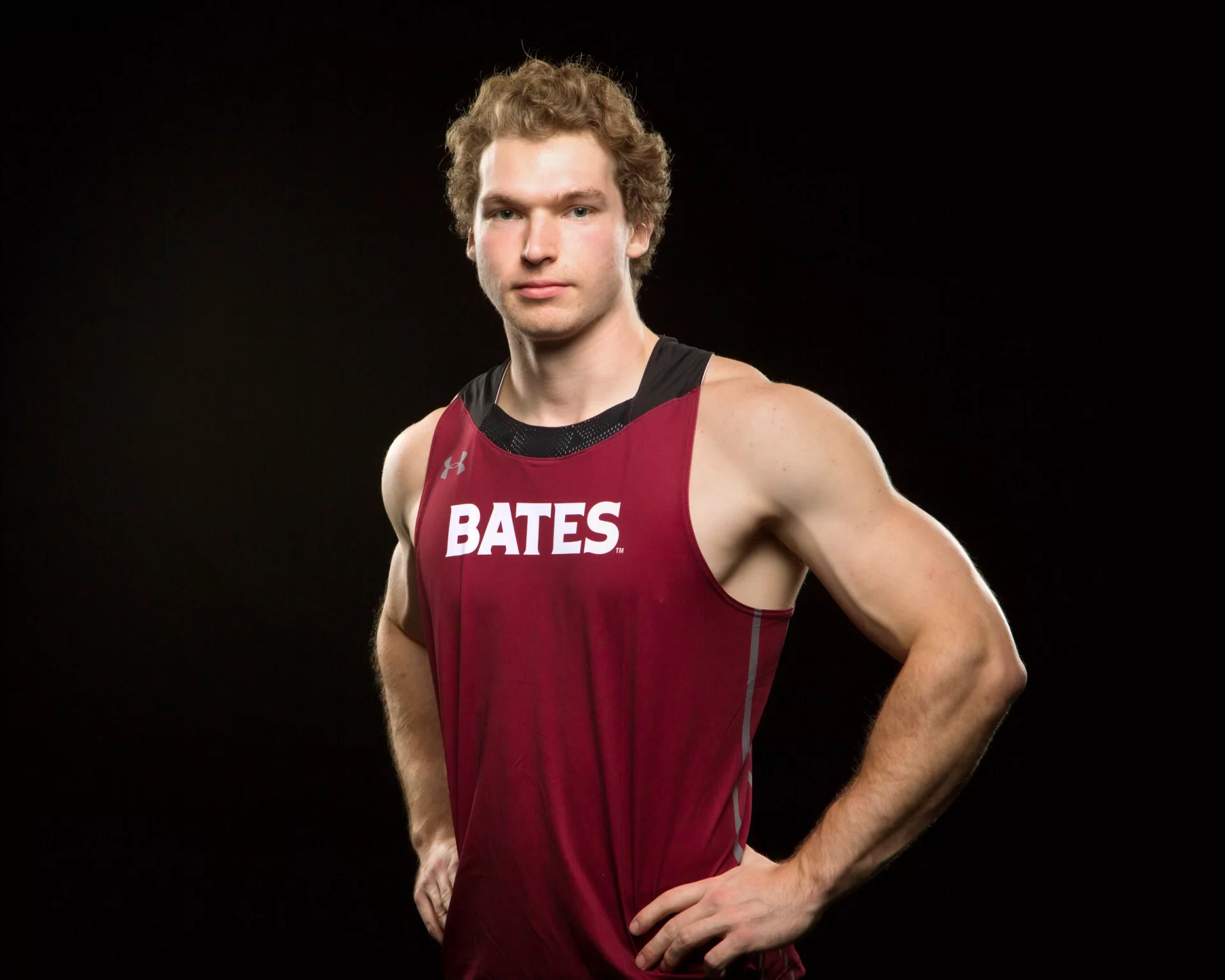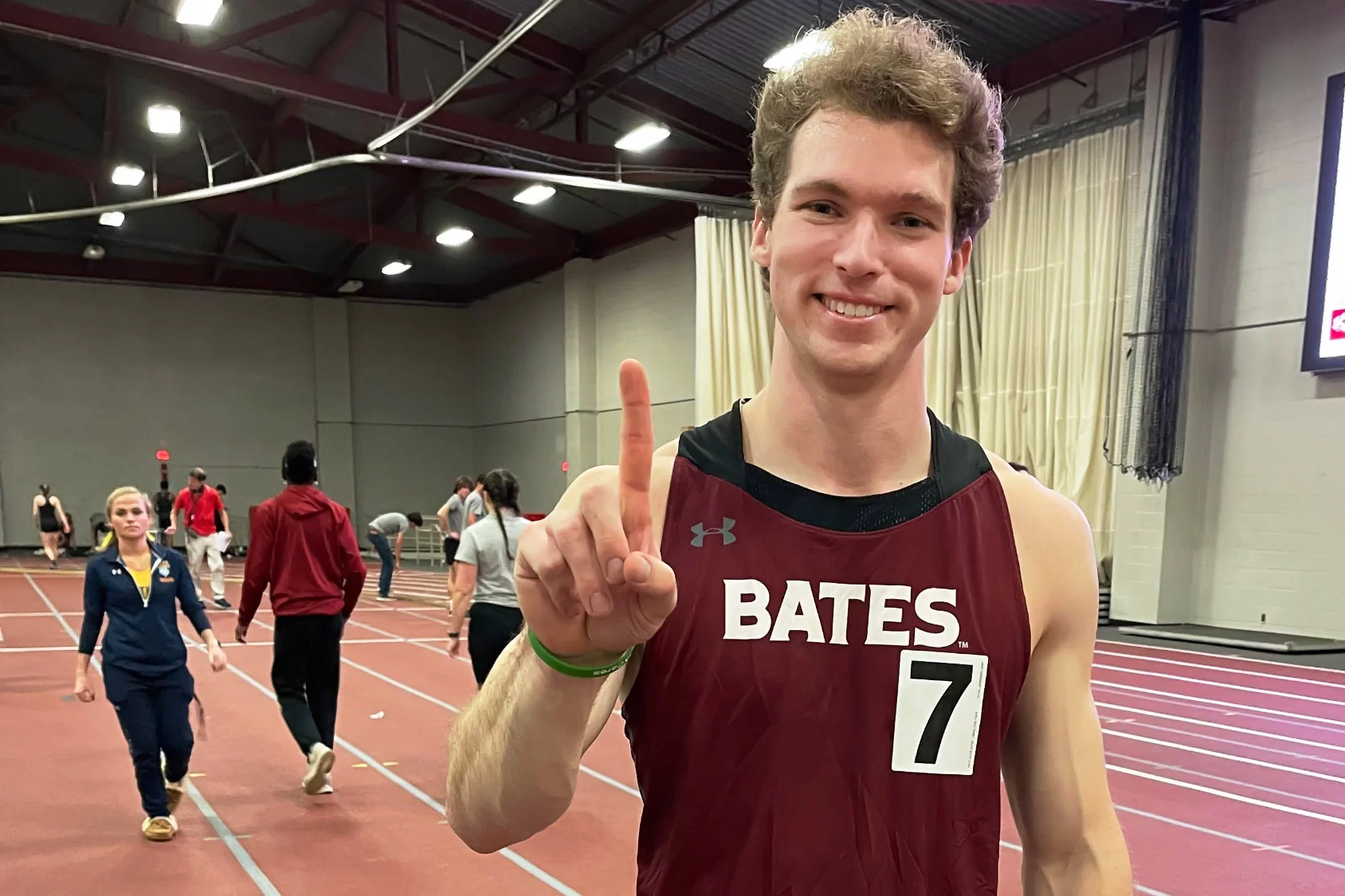
A football running back falls short of a first down by a few links of the chains. “It’s a game of inches!” they say on TV.
But how about a game of centimeters? That sport would be track, at least for Bates sprinter Colby Stakun-Pickering ’23 of Wellesley Hills, Mass.
Back on Jan. 13 at MIT, the senior captain established a Bates record in the 60-meter dash by just one one-hundredth of a second. A few days later, we asked the new record-holder if he could describe what 0.01 second looks like. Meaning, if he had defeated a foe by just a centisecond, what would the margin be at the finish line?
“About 10 centimeters,” said Stakun-Pickering, replying quite quickly, in fact, because he’s known the answer for about a year and because he has a mind for such things.

A mathematics and physics double major, Stakun-Pickering has finished a thesis, in physics, and is now starting a capstone project, in math.
Initially unsure of sure what he wanted to investigate for his physics thesis, he sought out a faculty mentor, Associate Professor of Physics Aleksandar Diamond-Stanik.
“He said was working on this project investigating the rate of star formation in distant galaxies, said Stakun-Pickering, who was a member of Diamond-Stanik’s student research group last summer and, with fellow Bates physics majors, attended the annual meeting of the American Astronomical Society in Pasadena, Calif., last June.
Intrigued, he embarked on a thesis project with Diamond-Stanic, looking at surprising recent research showing that fewer stars are forming than scientists originally thought. “It’s a lot less,” says Stakun-Pickering.
“If you make a simulation of a galaxy — here’s a bunch of gas and dust evolving over time — you might expect there to be, say, 100 new stars given the amount of mass and matter out there. But what we see is maybe only about 5 percent of that, or five stars that form.”
There are a few theories to explain the phenomenon, one having to do with the fact that the first stars that form then expand and ultimately explode. “I don’t know if you’ve heard but our sun is eventually going to expand and explode.”
(Yep, we’re aware!)
“That explosion disturbs and disrupts the cosmic gas that needs to condense to form stars. If you disturb all that settling gas, then you can’t make a star anymore.”
Stakun-Pickering is now taking his senior capstone mathematics course, with Professor of Mathematics Peter Wong. “It should be pretty fun,” he says. It involves integrals, which is a way of assigning numbers to functions to describe area and other properties.
Getting back on track: During a meet at Bowdoin last February, Stakun-Pickering and classmate Derek Shen ’23 of Bellevue, Wash., finished the 60 meters in nearly a dead heat for third in a time of 7:13 seconds.

The margin between them was “almost indistinguishable,” he recalls. “It took the officials probably two minutes to get the time.” The result required digital photo-finish technology, known as Fully Automatic Timing, which showed that Stakun-Pickering had beaten Shen by just a few thousandths of a second.
Stakun-Pickering got thinking about “the minute scale” of his sport, and about how getting faster means simultaneously decreasing a time and a distance.
So Stakun-Pickering used his Bates majors, math and physics, to help him visualize what a tiny fraction of time might look like in a race.
A sprinter like Stakun-Pickering runs the 60-meter dash in about 7 seconds. The first half of the race, as he gets up to speed, is slower than the second half. By the finish line, he’s zooming along at about 10 meters a second.
If you divide that one second by 10 meters, you get the distance he covers every 10th of a second: 1 meter. Divide again and you get the distance covered every hundredth of a second, 10 centimeters, or around 4 inches.
At MIT on Jan. 13, Stakun-Pickering sprinted the 60 meters in 7:05, a hundredth of a second faster than the record holder, Isaiah Spofford ’15, who sprinted 7:06 a decade ago. In other words, had they run head to head, Stakun-Pickering edged Spofford by that magical 10 centimeters.
Then, lo and behold, classmate Shen took over the record the following week, running the race in 0.03 faster to claim the record in 7:02, where it now stands. (It may change again while you are reading this article — the Bates sprinters and their teammates are back in action at the Maine State Meet this weekend at Merrill Gymnasium.)
And as far as how he’s gotten faster, Stakun-Pickering gives credit to head coach Curtis Johnson, former Bates sprint coach now in his second season leading the Bobcat program.
“It’s been really cool to see him go from sprint coach to head coach of the team, watching him tailor workouts to each person and making sure that they’re getting what they need to become the best athlete they can. That’s definitely helped me tremendously.”
As a kid growing up in Wellesley, Mass., Stakun-Pickering didn’t need a stopwatch to tell him he was fast. In fact, he was something of a playground legend. “We’d be playing tag, and kids get upset when you’re ‘It’ and you can just track them right down.”
In middle school, he got serious about sprinting when the stakes got higher. “My friend bet me that he was faster. The bet was over some really good pancakes that his grandmother makes. So, I signed up for the team, showed up to a practice, and was able to beat him.
“But I never ended up getting my pancakes!”
Being highly aware of time and distance and numbers “can help and hurt you” as an athlete, says Stackun-Pickering. Great athletes seek to achieve flow and mindfulness as they compete, and “you can go into paralysis by analysis, where you can think about it so much that now you’re starting to get in your own head.”
But in a positive sense, visualizing a fraction of a second as a few centimeters “helps me to think that even though Derek broke my record by 30 centimeters, that’s over the course of 60 meters. I mean, my phone is 15 centimeters. Hell, if I keep training for the next couple weeks and then put together a good quality race, anything can happen.”




